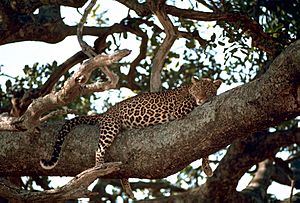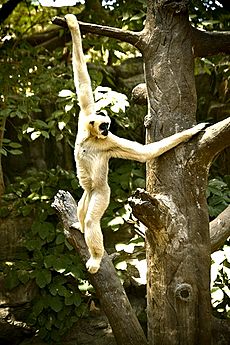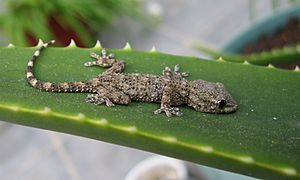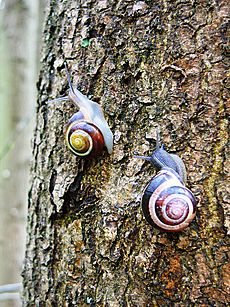Arboreal locomotion facts for kids
Arboreal locomotion is how animals move around in trees. Many animals have learned to live and move in trees because trees offer food, shelter, and safety. Some animals only climb trees sometimes, but others spend their whole lives in them. Moving in trees can be tricky, and animals have developed many special body parts and ways of moving to handle these challenges. These same ideas can also apply to climbing rocks or mountains.
Some animals, like the tree snail, live only in trees.
Contents
How Animals Move in Trees
Moving in trees presents many challenges for animals. They have found different ways to solve these problems. These challenges include moving on thin branches, going up and down, staying balanced, crossing gaps, and dealing with things in their way.
Branch Size
Moving on narrow surfaces, like a thin tree branch, can be very hard for animals not used to it. When an animal walks on the ground, its body can sway a little from side to side. But on a narrow branch, swaying too much would make the animal fall off. Animals that live in trees need to move on branches of different sizes. They also need to eat on these branches, so they must stay balanced while using their paws or hands to eat. Because of this, many arboreal animals have developed special ways to grip, like using their feet to hold onto small branches for better balance.
Going Up and Down
Tree branches often point up or down, which creates special problems. When an animal climbs up a branch, it has to fight gravity to lift its body. This makes climbing harder. To overcome this, many animals grip the branch with all four limbs. They also move their legs faster. When an animal climbs down, it also has to fight gravity to control its speed and avoid falling. Going down can be especially tricky. Animals that spend a lot of time in trees often have special ways to climb down safely. One way they avoid falling is by making sure more of their body parts touch the branch. This increases friction and helps them slow down.
Staying Balanced
Because branches are often high up, falling can be very dangerous. So, staying balanced is super important for animals that live in trees. On flat or gently sloped branches, the main problem is tipping over because the branch is narrow. The thinner the branch, the harder it is for an animal to balance. On steep or straight-up branches, tipping is less of a problem. Instead, the animal might fall backward or slip down. On very wide branches, it's harder for an animal to place its front paws closer to the center than its back paws.
Jumping Gaps
Some animals need to move from one tree to another to find food and shelter. To do this, they have developed different ways to cross gaps. In some places, trees are close together, and animals can simply swing across. In other areas, trees are far apart. Here, animals need special skills to jump long distances or even glide.
Obstacles in the Way
Tree habitats often have many things blocking the way. These can be branches growing out from the one an animal is on, or other branches getting in the way of its movement. These obstacles can make it harder to move. But animals can also use them as extra places to hold on, which helps them move better. While branches might slow down animals with limbs, they actually help snakes by giving them places to push off from.
Special Body Parts for Tree Life
Animals that live in trees have many special body parts that help them deal with the challenges of moving through their habitat.
Long Limbs
Animals that live in trees often have long arms and legs. These long limbs help them cross gaps, reach fruit or other food, and check if a branch ahead is strong enough to hold them. In some cases, long limbs help them swing from branch to branch. However, some types of lizards have shorter limbs. This helps them avoid their legs getting caught on branches that are in the way.
Gripping Tails
Many animals that live in trees, like howler monkeys, green tree pythons, chameleons, and spider monkeys, use their tails to grab branches. These are called prehensile tails. For example, the tip of a spider monkey's tail has a bare patch that helps it grip better.
Claws
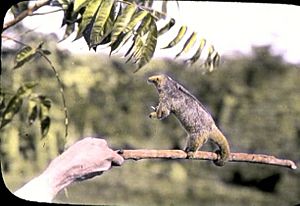
Claws help animals grip rough surfaces and change the direction of the force they use. This is how squirrels can climb tree trunks that are so big they seem flat to such a small animal. However, claws can make it hard for an animal to grip very small branches. This is because the claws might wrap too far around and poke the animal's own paw.
Sticky Feet
Having sticky feet is another way to climb, especially on smooth surfaces. Wet sticky feet are common in tree frogs and some salamanders. They work like suction cups or by using tiny amounts of water to stick. Dry sticky feet are best seen on geckos. They use tiny forces called van der Waals forces to stick to many surfaces, even glass!
Friction Grip
Primates use friction gripping with their hairless fingertips. They squeeze the branch between their fingertips, which creates a gripping force. However, this type of grip depends on the angle of the force, and thus on the size of the branch. Larger branches mean less gripping ability. Other animals that use gripping include chameleons, which have mitten-like grasping feet, and many birds that grip branches when perching or moving.
Feet That Can Turn Around
To control how they climb down, especially on wide branches, some animals like squirrels have very flexible ankle joints. These joints let them turn their foot into a "reversed" position. This allows their claws to hook into the rough bark, helping them fight gravity as they climb down.
Low Center of Gravity
Many tree-dwelling animals lower their center of gravity. This helps them stay steady and reduces wobbling when climbing. They can do this by changing their body position, having different body shapes, or simply by being smaller.
Small Size
Being small offers many benefits to animals that live in trees. It makes branches seem bigger compared to the animal, lowers their center of gravity, increases stability, and means they weigh less (allowing them to move on smaller branches). Small animals can also move through very crowded parts of the habitat. For gliding animals like "flying frogs," being small means they have less weight for their body length.
Hanging Under Branches
Some types of primates, bats, and all types of sloths stay stable by hanging underneath a branch. When they hang, tipping over or falling backward is not a problem. The only way they could fall is if they lose their grip.
Special Ways of Moving
Animals that live in trees have special behaviors for moving in their habitat, especially in how they stand and walk. For example, tree-dwelling mammals take longer steps. They stretch their limbs further forward and backward during a step. They also often crouch down to lower their center of gravity.
Birds and Tree Movement
Most birds usually fly or walk on the ground. But some birds are very good at moving in trees. Studies have shown that parrots use their head like a "third limb" when climbing trees. It's not clear if parrots use their head to push themselves up or just to stay balanced. Parrots have special nerves in their spine that help them live in trees, as they come from a very old family of tree-dwelling birds.
What Trees Offer Animals
Moving in trees allows animals to find different kinds of food and other resources. Larger animals might only be able to use wider branches that can hold their weight. Smaller animals might avoid competing for food by moving on thinner branches.
Swinging Through Trees
Brachiation is a special way of moving in trees. It's used by primates to move very quickly while hanging under branches. It involves swinging with their arms from one handhold to another. Only a few species are brachiators, and they are all primates. It's a main way of moving for spider monkeys and gibbons. Female orangutans also use it sometimes. Gibbons are the best at this. They can swing from branch to branch over distances of up to 15 meters (50 feet) and travel as fast as 56 kilometers per hour (35 mph)!
Gliding and Parachuting
To get across gaps between trees, many animals like the flying squirrel have developed special skin flaps, called patagia, for gliding flight. Some animals can slow down their fall in the air using a method called parachuting. For example, Rhacophorus (a "flying frog" species) has special toe membranes that help it fall more slowly after jumping from trees.
Climbing Without Limbs
Many types of snakes live in trees, and some have special muscles for this habitat. When moving in trees, snakes move slowly along bare branches using a special type of movement called concertina locomotion. But when there are other branches sticking out, snakes use lateral undulation, which is much faster. This means snakes do best on small branches in crowded areas, while animals with limbs seem to do best on large branches in open areas.
Animals That Live in Trees
Many, many kinds of animals live in trees. Here is a list of some well-known or mostly tree-dwelling animals:
- Primates
- Cats
- Fruit bats
- Brushtail possums
- Opossums
- Sloths
- Anteaters
- Treeshrews
- Goats
- Colugos
- Kinkajous
- Viverrids
- Tree squirrels and many other rodents
- Parrots
- Geckos
- Chameleons
- Many other lizards
- Green tree pythons
- Emerald tree boas
- Mambas
- Brown Tree Snakes
- Many other snakes
- Stick insects
- Many other arthropods
- Tree snails
- Koalas
- Red pandas
History of Tree Climbing
The earliest known four-legged animal to climb trees was a reptile-like creature called Eoscansor. It lived during the Late Carboniferous period in North America. It had clear adaptations for gripping, probably onto tree trunks. Suminia, another ancient reptile-like animal from Russia that lived about 260 million years ago, was also likely a specialized climber.
See also
 In Spanish: Arborícola para niños
In Spanish: Arborícola para niños
- Suspensory behavior
- Cursorial
- Fossorial
Sources
- Cartmill, M. (1974). Pads and claws in arboreal locomotion. In Primate Locomotion, (ed. F. A. J. Jenkins), pp. 45–83. New York: Academic Press.


